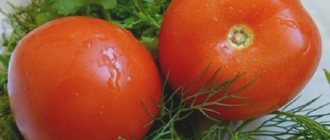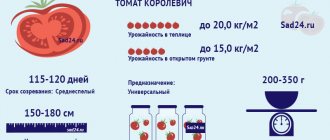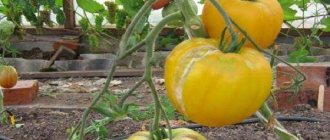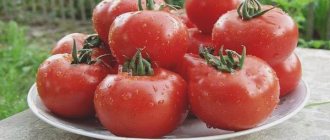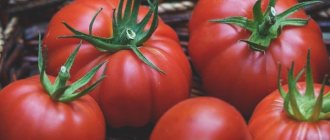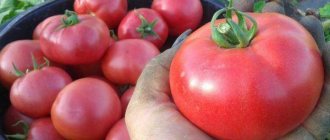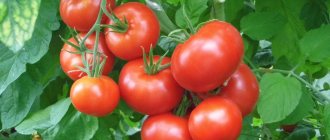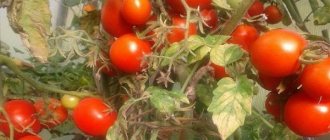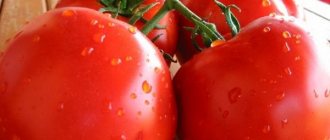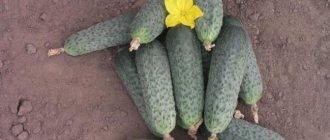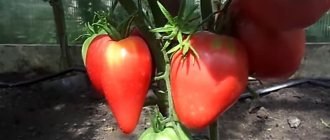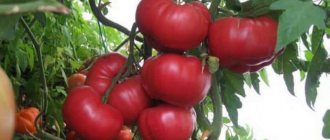Eagle beak
A tomato with the proud name Eagle Heart occupies the bottom line of our top.
Everyone who grows these giant tomatoes with an elongated tip, shaped like a heart, leaves only positive reviews about it. The weight of the fruit reaches 600-800 g, and sometimes up to 1 kg. One such pink-raspberry fleshy “bug” - and you can feed the whole family with salad! The tomato pulp is sugary, juicy and sweet. The variety is determinate, has a medium ripening period - in a greenhouse with nutritious soil the bushes grow up to 170 cm and require pinching and staking. In open ground they may be slightly lower. But their yield sometimes exceeds 10 kg per bush. For the sake of such impressive results, no effort is spared. Moreover, the tomato shows resistance to most diseases, does not lose its shape during transportation and can be stored for up to 3 months.
The bronze “medal” and 3rd place in the ranking goes to Eagle’s Beak, popular among many tomato growers! The variety is mid-season (110-115 days), semi-determinate - the height of strong bushes reaches 120-150 cm. Proper shaping, tying to a trellis and timely pinching will help them develop harmoniously and bear fruit well. Under ideal conditions and with proper agricultural technology, the yield can be up to 8 kg per bush.
“Eagle beak is the best, I have no competition yet, the leader for today.” Olga Nesmeyanova.
The fruits are large, of unusual shape, with an elongated and curved tip, similar to a beak. On average, they weigh 200-400 g, but some grow up to 800 g. The pulp is dense and juicy, with a sweetish taste.
The variety is resistant to the main nightshade diseases - late blight, fusarium and tobacco mosaic virus. Tomatoes tolerate transportation well due to their thick skin and do not crack during canning.
“I really like Eagle Beak!!!” Nina Belevtseva.
The absolute leader in the popular rating of tomatoes, which received a record number of votes, is the generally recognized and most popular variety, Bull's Heart! A real Senor Tomato in all respects!
The variety is late-ripening - the first fruits (5 pieces in a cluster) ripen 120-130 days after emergence. In open ground, the yield ranges from 3 to 5 kg of tomatoes per bush. In a greenhouse, this figure can increase to 12 kg. Determinate type bush - stems grow up to 1.5 m or more. To achieve record harvests, do not neglect care - timely shaping and tying to the support, preventive treatment against late blight - and the harvest will not keep you waiting!
What is a Big Rainbow tomato?
Characteristics and description of the variety:
- Big rainbow are large tomatoes; the weight of 1 fruit can reach 800 g with proper care.
- The shape of the tomato is flat-round.
- The coloring of the fruit is unique: red tomatoes have streaks of orange and yellow. The taste of the fruit is unusual. Feedback from farmers says that this variety of tomatoes is very tasty and sweet, and does not have the sourness characteristic of many other vegetables.
- Rainbow tomato has soft flesh.
- The fruits are suitable for preparing various sauces, juices, and also for fresh consumption.
The variety was developed by American breeders. Now it has become widespread in Russia. In the south of the country, tomatoes can be grown in open areas; in other regions characterized by a temperate climate, it is recommended to grow tomatoes in greenhouse conditions.
Tomatoes have a number of advantages that set this variety apart from others:
- Excellent taste - the sweetness and unusual taste allow us to get good reviews from buyers of the fruit.
- Wide range of applications for preparing various dishes.
- Unusual color and shape of tomatoes.
Video: TOMATO “BIG RAINBOW” (Big Rainbov, USA). No. 358. TASTING. Olga Chernova.
Video: Tomato – Big Rainbow (Big Rainbow)
Tomatoes also have a number of disadvantages that farmers should consider:
- The variety needs constant garter.
- It is necessary to plant tomatoes.
- The variety is not resistant to temperature changes and poor climatic conditions.
Despite the fact that Big Rainbow tomatoes are immune to some types of diseases that affect tomatoes of other varieties, it is necessary to carry out preventive work to prevent the disease.
Differences between tomato varieties
Each tomato variety has its own personality. Behind each are years of work by breeders and decades of popular selection. The beauty of the best modern tomato varieties is their diversity. So we “exploit” tomato hybrids and varieties with unlimited growth - indeterminate, semi-determinate, and determinate, the average height of which for the most part ranges from 70-80 cm, and low-growing vegetables, whose height does not exceed half a meter (all of them We will discuss the differences and features in the article below).
You cannot give advice based on outside experience, as some do, deliberately introducing not entirely truthful information about the yield (quantity and quality) of grown tomatoes. They say here they are - the best varieties of tomatoes of the past (and, further, in descending numbers) for tomatoes of the year. With everything, however, it should be noted that they often focus on plant varieties proposed for planting for open and closed ground, without understanding that the advice will be good only after personal experience - better after at least 3-4 years (honestly, but extremely rarely , and 2 are sometimes enough) and with meticulous experiments (starting with growing seedlings using the soil additive Vermiculite, the growth stimulator Gumi and, ending with fertilizing: magnesium sulfate, mineral fertilizer Fertika-Kemira and so on - already in the garden) for each variety.
Why am I giving such a deadline? Yes, because you definitely need to take into account the weather, which differs from year to year, and this is the minimum, in my opinion, period to have more or less an idea about each variety of tomatoes.
Koenigsberg
A mid-season variety of indeterminate (up to 2 m in height) tomatoes, which confidently took 10th place in our amateur rating. The first fruits usually ripen 110-115 days after sowing the seeds. Even beginners can cope with their cultivation. The variety has been tested and hardened in the harsh conditions of Siberia. Therefore, you can safely plant these tomatoes in open ground. Their productivity indicators are impressive - from 4 to 18 kg per 1 sq.m.
“Konigsberg performed well both in the greenhouse and in the OG.” Yuri Kuzminykh.
The oblong fruits ripen in clusters of 6 pieces, they weigh on average 300 g, under favorable conditions the weight can be 2-3 times higher than the standard declared by the manufacturer. Both the skin and the pulp of tomatoes are dense, which makes them easier to transport. Of course, they are healthier to eat fresh, but they are also very tasty in the form of juice, thick paste or sauce. There are varieties of red and yellow color (Golden Konigsberg).
“Konigsberg is an excellent variety, it bears fruit throughout October, from one bush to 2 buckets. In the greenhouse, of course." Lyudmila Petlyuk.
Landing in the ground
The seedlings are transferred to a permanent place around May, but the soil must warm up to 16 degrees, and there is no threat of frost (when planting in open ground). The holes are dug at a distance of 40-50 cm from each other, fertilizing is applied to them, then the soil is moistened. You should not plant more than three plants per 1 m2.
Since “Big Rainbow” is famous for its large fruits, the stem may not be able to support them, so it is advisable to install a trellis that will support the plant. This variety requires pinching; the bushes usually form 2-3 stems.
The “Big Rainbow” needs to be watered not so often, but abundantly. After the moistened soil, you can loosen it a little. Tomatoes should be fed at least once a month with proven complex mineral fertilizers or organic matter.
Tomato growing technology
The originator recommends growing plants using the seedling method. Preparatory work begins a couple of months before the planting date. Seed material is placed at a depth of 1.5–2 centimeters in pre-moistened soil. Strong seedlings are obtained by maintaining the room temperature at 21 degrees.
After hardening, the seedlings are planted in the ground. Up to three bushes are placed per square meter of land. Subsequent care activities consist of timely watering, tying and installing supports, loosening the soil, feeding and removing weeds.
Our technology for growing tomatoes of different varieties is as follows. On our plot we allocate 6 long rows for tomatoes (including closed soil). On three of them, representatives of the best varieties of tomatoes, proven over the years, are grown (there are also tomatoes to choose from), guaranteeing a harvest according to the declared characteristics (regardless of the “delights” of the weather), and the other three are planted with new varieties, which are “considered” this way and that in during the above time. That seems to be it.
PS To make life easier for readers and reduce the time it takes to absorb the article, instead of determining the yield of vegetables in kg per 1 square meter, it will be written below - kg “per square”.
And now I am announcing the number of tomatoes tested in growing, presented below for your viewing, which can still be called the best - 60 varieties.
PS The results were recorded in an area that: with a good warm season, corresponds to the Central Black Earth region (region), and with a bad warm season, corresponds to the North-Western region. Naturally, this range of latitudes in which the above regions are located definitely includes Siberia, the Moscow region, the Middle Zone, the Urals, the Far East, and then figure out for yourself where exactly the paths lead to your site.
Rainbow - variety of tomato plant
Variety characteristics:
Properties of the Rainbow variety:
Recommended region on the map:
Information on the admission of Tomato Rainbow from the Register of the State Variety Commission of the Russian Federation
Application for admission No. 43180, registered 2005-08-18. The Tomato Rainbow variety was included in the register of those approved in 2006. Approved for use in regions: All regions.
The originator of the Tomato Rainbow variety is:
Other varieties of tomato plant
Search for variety by name
Variety selection
Question to the portal experts
If you haven't found the answer to a question, don't hesitate to ask an expert.
Register or Login so you don't have to enter your Name and Email every time
Thanks for the comment! It will be published after checking by a moderator!
No comments yet, be the first!
A portal for those who love their dacha
Your question has been sent for moderation. Don't worry, we quickly check your questions and your question will be answered within 1 day.
We have noticed that you are already registered on our website. We recommend that you log in to view the question you created. If you don't remember your password, you can recover it.
You were not registered until today, so we have registered you. Your password has been sent to your specified mailbox.
Help our site develop!
Please read this message, it will not take up much of your time!
We so need your comments and questions to understand in which direction we should develop.
Don't forget to leave a comment if you found what you were looking for. And if you haven’t found it, use the “Ask an Expert” form in the site header. We will answer this question, and other visitors will be able to find the information that you could not find.
Sincerely, team of the portal Dacha-Dacha.ru
Your question has been sent for moderation. Don't worry, we quickly check your questions and your question will be answered within 1 day.
We have noticed that you are already registered on our website. We recommend that you log in to view the question you created. If you don't remember your password, you can recover it.
You were not registered until today, so we have registered you. Your password has been sent to your specified mailbox.
Abakan pink
On the 9th line - a variety of medium-late ripening (110-120 days from germination), determinate type (height - 70-80 cm). In a greenhouse it can grow up to 140-150 cm. The bush needs to be formed into 1-2 stems and tied up. It will ripen pink, heart-shaped fruits (weighing up to 300 g) with tasty, dense pulp. If cared for correctly, you can harvest tomatoes weighing up to 800g, rivaling in size the popular Ox's Heart.
There are many positive reviews about growing this tomato; no one criticizes it. It can be grown in Siberia, and to protect the bushes from returning spring or late autumn frosts, a light film cover will be enough. This representative of the nightshade family rarely gets sick; you will only have to ward off Colorado potato beetles from immature seedlings. In a word, it won’t cause you much trouble, and will delight you with tomatoes – both in salads in the summer and in preparations for the winter.
“I recommend Abakan pink. Unpretentious and very tasty." Lydia Domnikova-Kazakova.
Description of the variety
Refers to mid-season varieties, mature fruits appear 110-120 days after the first shoots have sprouted. The bushes are indeterminate, tall, and can be one and a half meters or higher. They have a powerful stem, the leaves are light green in color and medium in size. The fruits are large, their weight ranges from 500 to 800 grams. They have a flat-round shape. They also have a unique coloring on the red tomato: orange-yellow stains. The taste is excellent, the fruit is sweet, without sourness. The pulp is soft, perfect for fresh consumption, for making salads, as well as for sauces and gravies. This variety will make delicious juice.
The best varieties of tomatoes with descriptions
Before you accurately choose a variety or hybrid of tomatoes, you need to decide where exactly they will grow.
For open ground, low-growing varieties that will ripen early are more suitable. Mid-ripening species in good summer weather can produce a fairly good harvest, but they are susceptible to microflora, which can destroy most fruits.
It is customary to grow tall varieties and various hybrids in greenhouses. Here you can plant absolutely any tomatoes, even late-ripening ones.
Cio-chio-san
The only disadvantage of this indeterminate (sometimes growing up to 2 m) tomato is the need for support and shaping of the bush. The rest is a set of advantages! It is resistant to unfavorable conditions and can grow even in Siberia and the Far East. It bears fruit well not only in the greenhouse, but also in open ground. It is not afraid of the main nightshade diseases.
“In the greenhouse, I am always pleased with the Chio-chio-san variety from Gavrish. Maria Dolzhikova.
In terms of ripening time, the tomato belongs to the mid-early category - 100-120 days pass from the appearance of the first shoots to the start of fruiting. It won’t let you down with the harvest either - although the tomatoes are small (about 30-40 g on average), they ripen up to 50 pcs. on the brushes! So the yield from a bush with proper care is 4 kg and can reach a record 6 kg. And the taste of this tomato is excellent! And in the blanks it looks very presentable.
“Chio-chio-san - sweet, very productive, tall, with up to 50 smooth, thin-skinned sweet tomatoes in a bunch! Universal for both food and preservation.” Tatyana Vznuzdaeva. Tula region
I. Hybrids
Hybrid tomatoes are virtually guaranteed to be resistant to diseases and bad weather conditions, which is something that non-hybrid varieties suffer from. Greenhouses and greenhouses are valued for storing heat, but in them tomatoes can suffer from too high temperatures and sudden temperature changes. In recent years, world selection has been aimed at producing “heat-resistant” hybrids with a reliable guarantee of ovary production.
Hybrids are especially helpful in a greenhouse or a small garden plot where there are no real opportunities for crop rotation and diseases are prevalent. Selection successes demonstrate confident resistance to various types of infections - viral (especially the most dangerous tobacco mosaic virus), fungal, bacterial. In addition, the hybrids have uniform fruits and consistently high yields.
Tomato Incas F1
One of the best hybrids for canning whole fruits without skin. Popular early high-yielding bush hybrid. The plant is medium-sized, compact.
Tomato from the Dutch company Numens, zoned in Russia; entered into the state register in 2000. Mid-early hybrid (105 days) of meter-high vegetables, determinate. Very high resistance to fungal diseases has been recorded. The fruits are 80-100 g, dense, bright red, pepper-shaped, fleshy, uniform, tolerate sunburn well, are very easy to ripen, transported over long distances without loss of quality.
Tomato Torquay F1
Dutch hybrid from Bejo Zaden; in the Russian register since 2007. Mid-season tomato (119-123 days from germination to ripening), bush type - determinate, maximum height 100 cm. Forms abundant multiple clusters with fruits weighing 60-140 g. Dense tomatoes withstand long-term transportation, excellent in pickling and pickling matters.
Tomato Mariana F1
The tomato was created in the French branch of the Japanese company Sakata (the image of the woman Mariana is a symbol of the French Republic). The breeders of this agricultural company are often suspected of producing GMOs, but so far without real evidence. Mariana is a mid-early determinate hybrid. The fruits are similar in shape to Incas - also elongated-oval, perfectly smooth, super dense.
Tomato Bagheera F1
Hybrid from the leading French seed company Cloz. Included in the Russian seed register in 2007.
Early high-yielding hybrids are a real boon for the garden. They are cold-resistant, do not need pinching or tying up, and practically do not get sick. The ripening period is marked as medium-early; determinate bush. The fruit is round, flattened on top, ribbed, weight ranges from 80-220 g. The hybrid is resistant to soil drought and nematode, more suitable for regions located in the south. Does not suffer from fusarium and verticillium wilt.
Tomato F1 Semko 2005
The tomato is suitable for open ground and under film shelters (greenhouses). Determinate, medium-sized, compact. Resistant to soil salinity, drought, high temperatures, grows well in open ground in both southern and northern regions. Vegetables practically do not suffer from viral and fungal diseases, even late blight.
Tomato F1 Semko 2010
Included in the state register in 2010. Ultra-early ripening determinate hybrid - 85-88 days pass from the sprouting of green vegetables to the coloring of fruits. The first brush is formed immediately after the sixth leaf grows. The fruits are incredibly dense for such an early tomato, and are by no means small - 130 g. The shape is round hearts with a beautiful pointed tip.
The newest indeterminate hybrid (on the register since 2015) - tested by us, everything is fine - created taking into account all possible greenhouse disasters. Firstly, it sets well even in the heat, as well as during temperature changes. Secondly, it is tolerant of problematic soil substrates. Thirdly, it shows high resistance to viral, fungal and bacterial infections.
The yield of vegetables varies between 20-30 kg/1 square meter. Mid-early hybrid (100 days from green shoots). The clusters begin to form after 7-9 leaves, each bears 5-6 tomatoes in the shape of rounded hearts, smooth, beautiful, attractive orange color. The weight of the “heart” is 160-190 g. The pulp contains a high percentage of dry matter, sugars, and carotenoids. The fruits are quite dense and do not wrinkle during transportation. Purpose: salad. Created as an orange variant of another hybrid - Tomato Pink Spama.
Bushes of unlimited growth, with dense foliage. Mandatory shaping is required, including a garter. Hybrid of medium early or medium ripening period (112-118 days). Clusters of 6-8 tomatoes weighing 130-150 g. The fruits are plum-shaped, slightly tapering downwards. They are deep red in color, thick-skinned, with a high percentage of dry matter.
Tomato Empire F1
Indeterminate hybrid of a new generation, in the state register since 2011. Medium-early (100 days - 2 days - from germination). The plant is tall, much taller than other types of tomatoes. Therefore, the tomato requires gartering and pinching. Tomatoes are oval-shaped with a spout, weight ranges from 80 to 140 g. On average, 9 kg are obtained per bush. The color of the fruit is red-orange. The skin and pulp are dense. Can be stored for 6-7 weeks. In greenhouses people do not suffer from viral and fungal infections.
On the register since 2015. The bushes are semi-determinate, beautiful, a meter and a half high. Suitable for any soil - open or closed. Plants require pinching. Multiple clusters bear up to 30 fruits with a sweet taste and a perfect “strawberry” shape. The weight is typical for classic cherry tomatoes - 25 g. Thanks to the strong skin, the fruits can be stored for a long time. Early hybrid: ripe fruits appear 91-93 days after the sprouts emerge. The plant is resistant to Fusarium wilt.
Tomato F1 Kaspar
The bush is short, usually up to the first cluster, 60 cm. The fruits of the plants are cylindrical with a spout, the length varies around 11 cm, and the weight is 95-115 g. They are very dense, without juice. It is convenient to pickle them assorted with cucumbers of a similar size.
The average ripening period is 115 days. The hybrid is intended for open ground, or is planted under low shelters; We plant three to four vegetable bushes per square.
Tomato Aunt Valya F1
Valya f1 tomatoes are early-ripening, tall hybrids with average yield. The bushes easily and quickly reach a height of 200 cm. In the register since 2015. Productivity is within 20 kg per square meter. On average, one bush produces 7 kg of tasty and beautiful tomatoes. Tomatoes ripen simultaneously, reaching 200-250 g in weight.
The fruits have a regular round, slightly oblong shape. The scope of use of tomatoes is very wide. Salads are prepared from the first fruits. As the volume of the harvest increases, the fruits are used for winter harvesting, as well as juices, ketchups, pastes, sauces and lecho. Tomatoes retain commercial quality for a long time and tolerate transportation and long-term storage well.
Yablonka Russia
Tomatoes with such a reverent name could not help but get into the top - they ripen early - from the time the first shoots appear until the moment when the bushes are completely strewn with small round fruits (weighing about 100 g) and really similar to bulk apples, it takes from 118 to 135 days.
Many consider this tomato to be problem-free - it is determinate, standard bushes grow low - up to 100 cm; there is no need to shape them and pin them; They are not capricious and feel great and set fruit both in the greenhouse and in the open ground. One bush can simultaneously ripen up to 100 neat tomatoes suitable for canning - the skin will not burst, there is no need to worry. Not a tomato, but just a sight for sore eyes!
II. Indeterminate varieties (unlimited growth)
These are tomatoes that will grow until they turn blue until the owner or the onset of the cold season stops them. They have great yield potential, which is more successfully realized in high greenhouses. We place approximately three bushes on 1 square. With supports such as strong trellises, open ground is not prohibited, which will be especially welcome in the southern regions.
Tomato Scarlet candles
Good for pickling, sweet. This is a patented mid-early variety (Siberian breeders distinguished themselves!). In the state register since 2007. They are characterized by a high ability to form ovaries in any conditions. From 1 sq.m you can actually get a bucket and a half. The clusters are arranged in tiers, the weight of the fruit on the lower branches reaches 120 g, on the top ones - half as much.
Very lightweight. A mid-early Siberian variety for canning whole vegetables. The fruits are elongated, reaching (maximum in our conditions) 13-14 cm in length, weighing about 120 g, and have a beautiful crimson hue. They have few seeds, are very fleshy, strong, and easy to keep. If they are picked green, they do not spoil and ripen perfectly.
The longest
A new product of Siberian selection. It begins to ripen already on the 110th (you can add a couple more) days from the sprouts appearing on the surface of the soil. Fruits have a unique length - 20 cm (specific size)! They are very elongated, with a small pear-shaped constriction in the upper part, uniformly slightly expanding downwards, with a spout. Vegetable clusters bear up to seven red fruits weighing up to 180-190 g. The product is successful in transportation, long-term storage, and pickling. Collection - at least a bucket from three plants.
High yield
The variety is productive and unpretentious. Tolerates slight shading. It ties well. Neither high nor low temperatures are scary. It succeeds in protected soil, but outdoor cultivation is not prohibited. Tomatoes begin to ripen in 106-113 days; at the same time, the plant successfully continues to grow and form clusters - up to 10 pieces per bush.
Each bears up to eight graceful fruits - cylindrical and pointed, in full ripeness - iridescent pink in color. The weight of each vegetable is 100-120 g. They contain a high percentage of sugars and dry matter. They do not burst when pickled, are good for drying, obtaining thick juice and, oddly enough in your opinion, for making tomato jam. With diligent care, the bush can bear up to a bucket of quality fruit.
Tomato Niagara
Weighty brushes
This mid-early vegetable variety has been on the state register since 2010. The bush is tall, but compact in width. It has a highly branched root system, responsive to increased nutrition and good water supply. A valuable feature of this Siberian variety is its multiple clusters, each of which bears up to 14 fruits weighing 85-115 g.
Meaty and sweet
This is one of the sweetest and meatiest products of Siberian breeders. It has been registered in the state register since 2007. The tomato is mid-season (116-118 days from the appearance of sprouts), with large foliage. The fruits resemble long, sharp peppers - they grow up to 15 cm. They are an elegant red color, the weight ranges from 120-185 g. The pulp of vegetables contains very little water and seeds. In the best case, there are up to a dozen fruits in one cluster. One bush gives 2-3 kg.
Tomato Koenigsberg
Excellent ovary
Included in the state register in 2005. The variety rightfully takes its place among the most productive Siberian varieties (up to 20 kg per square meter of land in a greenhouse). It sets perfectly even in the hot atmosphere of closed ground. Plants with a powerful bush with large leaves require increased nutrition and careful pinching.
The first ovary is formed after the growth of the 12th leaf, then inflorescences are formed every 3 leaves. Refers to varieties of medium ripening; in Siberian conditions, approximately half of the crop ripens; the rest of the fruits turn red quite well when ripened. Tomatoes in the lower clusters of vegetables weigh 300 g, and in those above - no less than 150 g. The shape is elongated, heart-shaped, smooth, and beautiful.
Vitamin and sweet
Ripe tomatoes have a golden-orange color and contain a record amount of carotene vitamins. The pulp is sweet and aromatic, like berries and fruits. The ripening period is average. The lower fruits are capable of filling up to a mass of 400-450 g, higher up the bush - 200-300 g. They are oval, often with a spout. The plants grow clusters through the leaves, each containing on average, as stated, up to 5 fruits. Productivity is high. The keeping quality is excellent. It is especially tasty when salted with gelatin.
Harvest hearts
Close internodes and a powerful trunk with dense foliage are like standard varieties, only the height is two meters. The Siberian breeding novelty produces half a bucket of fruit from one such “tree”. Ripening begins on the 115th day. Forms up to 6 beautiful clusters with 5-7 red tomatoes weighing 200-250 grams, shaped like strawberries.
Tomato Budenovka
Resistant to cracking
The variety is an improved version of Ox Heart, with a higher yield (about 9.4 kg per square), early ripening, good resistance to diseases (even to late blight) and cracking of the apical tissue of the fruit for a fleshy variety. Heart-shaped, ribbed tomatoes with excellent taste.
Record weight
The variety is a new product from a team of breeding scientists under the leadership of V.F. Gavrisha. Registered in the state register in 2015. Due to the unrealistically large fruits of vegetables, it is included in the “Russian Hero” series. The variety is not very fast in terms of ripening time (from 120 days), therefore it requires early planting of seedlings, especially careful pinching and decent feeding.
In Siberia and Central Russia it works well only in closed ground conditions, including a greenhouse. The average return from a bush is 3.6 (plus or minus) kg, the record is 7 kg. The tomatoes are flat-round, slightly ribbed, have an excellent smell and are very juicy, each weighing 400-600 g, not uncommon - 800 g. There are 2-3 tomatoes in one cluster of plants; if you leave only one tomato in it, it can pull more than 1 kg. Such “bogatyrs” are better suited for salads and distillation for juice.
Bowl of salad from one fruit
One of the best salad novelties, the yield is high. The plant bears 5-6 racemes. The fruits look very attractive due to their raspberry-pink color, large up to 500-800 g. The tomatoes are flat-round, ribbed, sweet. There is high resistance to cracking; The pulp density is average. A rare quality for large-fruited varieties: the fruits do not tend to quickly soften and spoil during storage.
According to the ripening period, the variety is classified as mid-early and mid-ripe. Perfect for preparing preparations: tomato paste, juice. This tomato variety is characterized by high yield. You can remove up to 5-6 kilograms of tomatoes from one bush.
Giant orange sweet
It has plasticity, rare for a large-fruited variety, and relative unpretentiousness. Delicate sweet pulp combines with excellent keeping quality. The tomatoes are round-flat (their “ribs” stand out a little), sunny orange in color. The average weight of a tomato is 0.5 kg, but in reality there are 1 kg of fruit on the bush.
Tomato Honey Drop
Sweet babes
Tomatoes from the “cherry” group, original in shape and color. Golden-yellow “pears” weight 30 g. Potato-type foliage, the bush of the plant is incredibly branched: stepsons strive to grow even at the ends of the flower racemes. But in the greenhouse you still need to remove the branches (at least partially), otherwise you will end up with a jungle. Vegetable clusters are multi-fruited clusters and the overall yield is very good. The fruits on the clusters below ripen 105 days after germination.
Plum sweets
A modern variety of breeders under the leadership of V.F. Gavrisha, a new product in the group of cherry tomatoes - the Monisto series. The year of entry into the state register is 2015. First harvest on the 115th day. The tomatoes are oval, weighing 25-40 g, collected in clusters of 30 pieces. The variety is the most unusual in color among tomatoes. It has fruits of a brown-burgundy hue, with a specific set of vitamins and an original taste.
Tomato Big Rainbow - description and characteristics of the variety
Variety property
The Big Rainbow tomato is a mid-season variety and ripens within 120 days from the appearance of the first shoots. The bushes are tall, reaching 1.5 meters in height, sometimes more, so their growth is limited. Their stem is bubbly and large, the leaves have a light green tint, are not too large in size, closer to average.
The harvest is harvested in buckets, the smallest weight of ripe fruits is half a kilogram, and the maximum reaches 800 grams. The foreign appearance is interesting: a round, slightly flattened shape, and their ruby color is diluted with orange and yellow splashes.
Making salads from them is a lot of fun; the juicy pulp gives an excellent taste. The tomato juice from this variety is of excellent quality, you drink it and still want it.
The variety was brought to our country from the United States of America. Sympathy is growing in all Russian regions, the only differences are in growing conditions - depending on the climate. In the southern part of Russia, tomato seedlings are planted in open ground, while in other regions planting takes place in a greenhouse. In Siberia and the Urals, greenhouses are even heated.
Advantages and disadvantages of the variety
In general, like all vegetable crops, the Big Rainbow tomato has certain pros and cons.
The advantages of this variety are:
- luxurious product appearance;
- excellent nutritional properties;
- various areas of application;
- original shape and color.
The obvious disadvantages of tomato include:
- obligatory garter of bushes;
- you have to do stepsoning;
- ratio of harvest size and care;
- not completely adapted to cold climates.
Features of caring for seedlings
Tomato seedlings are planted in a greenhouse in mid-May, thanks (it is advisable to sow them at the end of February, the deadline is the overture of March. Planting in greenhouse soil is carried out 2 - 2.5 months after the seeds have sprouted. If the seeds are not sown in a special fertile soil sold in the store, and in previously abandoned garden soil, then peat, sand and humus must be added to such soil. All ingredients are taken in equal parts, plus a little ash is added. The seedling soil mixture is mixed well. If desired, it can be fertilized with phosphate additives . Self-made soil requires processing - disinfection. The most popular method is steaming. This procedure requires a large container, which is filled with water, and covered on top with a piece of natural fabric material, secured with an elastic band. The earthen mass is poured into it, the pan is placed on the fire. Processing movement finished after the water has completely boiled.Thus, pathogenic microbes and bacteria will die. Immediately before sowing, it is advisable to check superelite for germination. To do this, you need a five percent salt emulsoid into which seeds from a store-bought bag are dipped. We throw out the floating specimens, and prepare the rest of the remains remaining at the bottom for planting. First, we pickle them in a manganese solution for about half an hour, after wrapping the seeds in gauze. Then we dry them and place them in a growth stimulator for 12 hours, so they will germinate faster. After planting, we thoroughly water the soil, perhaps using a sprayer. Be sure to create a greenhouse effect for the seedlings and cover them with polyethylene. For the first two weeks we water it every day. After the shoots appear, we thin them out and remove weak shoots. At the stage of appearance of two true leaves, a picking session is performed
To avoid damaging small bushes, we carry out picking with the utmost care. In the future, the seedlings will gain strength and little by little they will be ready for planting in a permanent place.
Planting mature plants
Seedlings are planted in clear soil only at the end of May, but they can be planted in a greenhouse even earlier. The earth should be warmed up to +16° C, and the distance between plants should be about half a meter. First, fields are laid in the prepared holes), then they are watered, and only after that the tomatoes are planted.
For the Big Rainbow variety, immediately after planting, wooden pegs are placed near the bushes to which they are tied.
Planting program: no more than 3 plants per square meter.
Monomakh's hat
6th step of the conditional “pedestal”. These bright red tomatoes will appeal to lovers of large fruits - they weigh from 400 to 900 g. The pulp has a balanced taste thanks to the harmonious ratio of acids and sugar.
The type of fruiting is mid-early (90-110 days pass from the moment the seedlings are planted). The bushes are indeterminate, formed on a trunk. The plant successfully resists diseases, but prefers warmth to cold, so in the northern regions it is better to plant it in a greenhouse. In protected soil conditions, the yield is impressive and reaches 20 kg per 1 sq.m. In the garden, the indicators are also decent - up to 8 kg per bush.
Gardeners' opinion
Good day! Last year I tried to grow a new tomato variety, Big Rainbow. The variety is demanding, loves feeding, requires tying up. In the North-West region, cultivation can only be done in protected soil conditions. The harvest was decent, the fruits were large and sweet. The berries have an unusual color. The variety is for everyone, I liked it. I leave positive reviews for the American originator.
Valentina Novikova, 53 years old
Good afternoon! For lovers of large-fruited tomatoes, I recommend Big Rainbow. The plant from American breeders requires moderate attention, loves feeding and requires garter. Does not tolerate sudden changes in temperature; it must be grown in greenhouse conditions. The color of ripe fruits is red with yellow streaks, the taste is excellent. I recommend!
Puzata hut
In terms of the number of votes received, it was not far from Monomakh's Cap. The appearance of these tomatoes fully explains the name. Large (300 g), pear-shaped, ribbed, just like squat gnome houses, these tomatoes ripen early - 105-110 days after planting the seedlings. True, they turn red gradually if there is a lot of heat and sun. They are grown in open ground and under film, where they ripen faster. The fruits are fleshy, taste very sweet and juicy.
The bushes are indeterminate, but even in a greenhouse their height rarely exceeds 170 cm. However, it will not be possible to do without shaping. The stems are thin and need staking, as they can lie down under the weight of the fruit. And the yield of these tomatoes, ripening in clusters of 3-5 pieces, is quite decent - 10-11 kg per bush. They are little susceptible to common cultural diseases, but preventive protective measures have never hurt anyone.
“This year I also want a Puzata hut. Last year a friend had them - just a miracle!” Marina Samoilova.
Growing seedlings
In order to plant seedlings in greenhouses in May, they must be sown already in February, that is, 60-65 days before transferring to a permanent place. First of all, you buy fertile soil at a gardening store, or you can make it yourself. To do this, you will need peat, sand, soil from the garden and humus in equal proportions, add a little ash and mix thoroughly. You can also fertilize the mixture with 2% phosphate fertilizers.
To disinfect the resulting soil, you can use a method such as steaming. For it you will need a pan with water, a natural fabric is placed on top of it, secured with an elastic band and the mixture is poured out. Afterwards, the container is placed on the fire, and you just have to wait until the water boils away. This procedure will help destroy larvae and microbes.
Before planting, it is better to check the seeds for germination; this can be done using a regular 5% saline solution. Seeds are dropped there, those that have floated empty and will not sprout, those remaining at the bottom can be sown. In order for them to sprout faster, they are placed in a growth stimulator for 12 hours.
Before planting, dressing is also recommended; for this, potassium permanganate is used, in which the seeds are immersed in a bag made of gauze for 30 minutes. Then they are taken out and washed well under running water. After this procedure, they need to be dried, now the seeds are completely ready.
After planting, you need to immediately water the soil; it is better to do this the first time with a sprayer so as not to displace the seeds. And before the sprouts appear, I cover the container with the seedlings with film, creating a greenhouse effect. Plants need daily watering for the first two weeks, then this can be done less frequently. When all the seedlings appear on the surface of the earth, you can remove thin and weak seedlings, leaving a distance of at least two centimeters between plants.
You can dive into separate cups if the young seedlings have two true leaves. This must be done with caution, because you can accidentally damage the fragile plant. Before planting in the soil, young seedlings are hardened off so that they become stronger and more resilient.
Golden domes
The collected votes allowed these tomatoes to take 4th place in the rating. They have a lot of good reviews, since the variety has almost no flaws, for which it is recognized and loved by many. It exhibits high resistance to major diseases, and timely applied insecticides will repel harmful insects.
Determinate bushes (height from 90 to 150 cm), medium ripening period (100-116 days). You will still have to form it into 2-3 stems and tie it up, so it won’t be possible without any effort on your part. The yield is very good - up to 13 kg per bush with an average weight of tomatoes of 200-400 g, and if the care is good, they will gain all 800 g! Ripe fruits are bright orange, juicy even in appearance. The pulp is fleshy, very tasty, sweet.
“I love golden domes very much - tasty, productive and beautiful. Excellent variety! Lyubov Chernoguz.
De Barao
Having pulled away from its “rivals”, the famous De Barao tomato variety takes an honorable 2nd place in the top varieties. The variety is late-ripening (ripening dates vary from 110 to 130 days from the moment of planting the seedlings), indeterminate (2-3 m), sometimes bushes can grow up to 4 m. The main advantages of the variety are its cold resistance, shade tolerance and productivity.
“The tall De Barao produces stable yields in any weather: in rain, in heat, even in the shade.” Tatiana Trach.
The productivity of De Barao is exceptional - from one bush you can collect from 4 to 10 kg of strong, oblong-shaped fruits weighing about 100 g. It is noteworthy that the plant produces its harvest over a long period of time (up to 3 months). There are varieties with pink, red, yellow and black fruits. Tomatoes store well due to their thick skin and for the same reason are suitable for pickling or pickling.
“The only one who stood in the greenhouse and ripened in October was De Barao. Resistant tin...” Tatiana Gorodetskaya.
Features of cultivation
We recommend sowing the seeds of this tomato variety for seedlings 60-65 days before the intended planting in the ground. When planting seedlings per 1 sq. meter there are up to 3 plants.
If you grew Big Rainbow tomatoes, please write how this variety performed in your conditions. If possible, attach a photo of these tomatoes to your comment. Thank you!
Your reviews of the Big Rainbow tomato and additions to the description will help many gardeners evaluate this variety more objectively and decide whether it is worth planting or not.
The Big Rainbow tomato is an excellent choice for those gardeners who prefer to grow sweet tomatoes, while they are characterized by an unusual taste and appearance.
